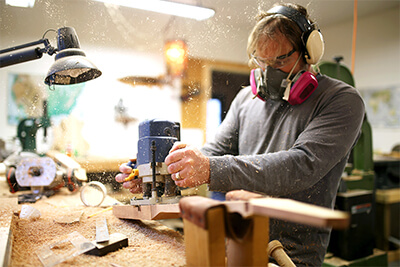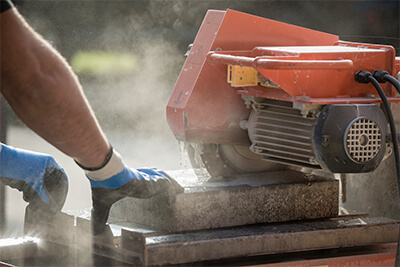Construction
Overview
The construction industry is involved in the planning, design and constructing of buildings or infrastructure projects. The repair and renovation of existing buildings also falls under the construction industry. The three main sectors of construction include:
- Buildings (both residential and non-residential)
- Infrastructure (bridges, highways, dams, public works)
- Industrial (refineries, mills, manufacturing and processing plants)
Demand for construction projects and equipment in recent years has grown at a steady pace. In most developed countries, construction makes up about six to nine percent of the gross domestic product (GDP).
Woodworking
Commonly used in the construction industry, woodworking entails the many processes involved with the fabrication of wooden structures.  The planing, sawing, routing, milling, drilling and sanding of wood are all woodworking applications. Each one of these processes create large amounts of dusts that can harm worker health.
The planing, sawing, routing, milling, drilling and sanding of wood are all woodworking applications. Each one of these processes create large amounts of dusts that can harm worker health.
Potentially causing nasal, paranasal and nasopharynx cancers, the International Agency for Research on Cancer (IARC) has classified wood dust as a carcinogen. But it’s not just cancer that workers need to worry about. Wood dust exposure can lead to a wide range of concerning conditions.
The type of illness depends directly on the species of wood. Cedar dust, for example, can lead to asthma, allergic contact dermatitis, rhinitis, decreased lung function, or eye irritation and conjunctivitis. Exposure to oak dust, on the other hand, can cause nasal cancer.
Other conditions that may result from wood dust exposure include:
- Shortness of breath
- Dry, sore throat
- Conjunctivitis
- Occupational asthma
- Chronic bronchitis
- Hypersensitivity pneumonitis (inflammation of the airways and air sac walls)
Chemicals from the wood dust enter through the worker’s skin, lungs and digestive system. Once absorbed, these wood chemicals can cause a number of symptoms such as:
- Giddiness
- Headaches
- Weight loss
- Breathlessness
- Cramps
- Irregular heartbeat
But it’s not just the wood itself that can lead to illness. Wood dust often contains mold, fungi and bacteria which can cause hypersensitivity pneumonitis, Maple Bark Stripper’s disease or Wood-Pulp Worker’s disease.
Given the right conditions, wood dust is also combustible. If allowed to accumulate in duct work and on factory surfaces, fire and explosion can result, putting workers’ lives and welfare as well as company property at risk.
Both the Occupational Safety and Health Administration (OSHA) and the National Fire Protection Association (NFPA) have guidelines in place to protect worker health and safety. Installing local exhaust ventilation systems is the best method to capture and remove wood dust at source.
Helping keep businesses in the woodworking and construction industries NFPA and OSHA compliant, Diversitech offers a number of combustible dust filtration options. Our wet dust collectors and wet downdraft tables safely capture flammable dusts and help protect workers from wood dust related illnesses.
Stone & Masonry
One of the oldest forms of construction known to man, masonry is involved with the building of structures using brick, concrete, stone or tile and bonding them with mortar.  The stone industry on the other hand, manufactures countertops, fireplaces or other stone-made fixtures for homes and offices.
The stone industry on the other hand, manufactures countertops, fireplaces or other stone-made fixtures for homes and offices.
Both sectors are involved with the cutting, grinding, milling, drilling, chipping and polishing of stone, concrete and brick. These processes create vast amounts of dust that present a real threat to worker health if inhaled.
Because these masonry materials all contain the chemical compound crystalline silica, workers in these industries are at high risk of developing serious health conditions. Inhaling silica particles can scar the lungs and lead to the incurable lung disease called silicosis. Characterized by symptoms such as shortness of breath, coughing, wheezing and chest tightness, there are three forms of silicosis workers can develop with exposure: acute, accelerated and chronic silicosis. Chronic silicosis is the most common and occurs after 10 years of exposure. Acute silicosis can be deadly after months of high exposure.
But silicosis isn’t the only disease resulting from inhaling crystalline silica. Tuberculosis, lung cancer and kidney disease have all been associated with silica dust.
Materials that commonly contain silica include:
- Concrete
- Asphalt
- Granite
- Brick
- Ceramic tile
- Mortar
- Sand
- Slate
- Terrazzo
- Roof tiles
OSHA has classified silica as a hazardous contaminant and recommends worker exposure should be limited to no more than 50 micrograms per cubic meter over an 8-hour shift. To protect workers from the dangers of crystalline silica, businesses need to implement engineered controls for the safe collection of dust.
Understanding the unique problems that businesses in the stone and masonry industries face, Diversitech offers a number of cartridge dust collectors for the effective capture of airborne silica dust.